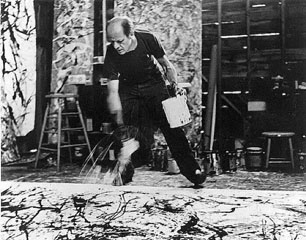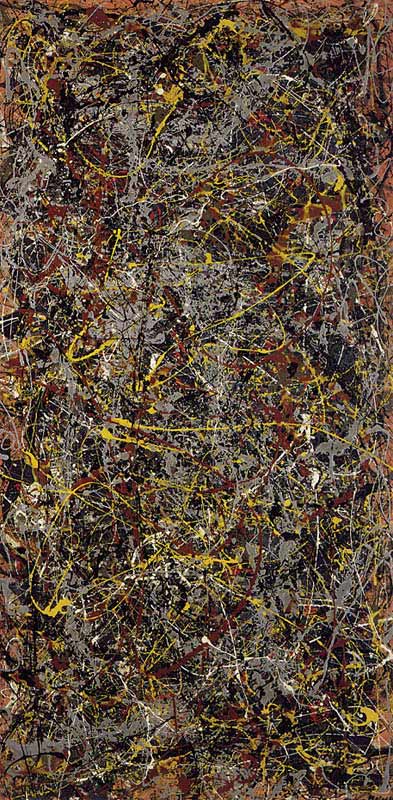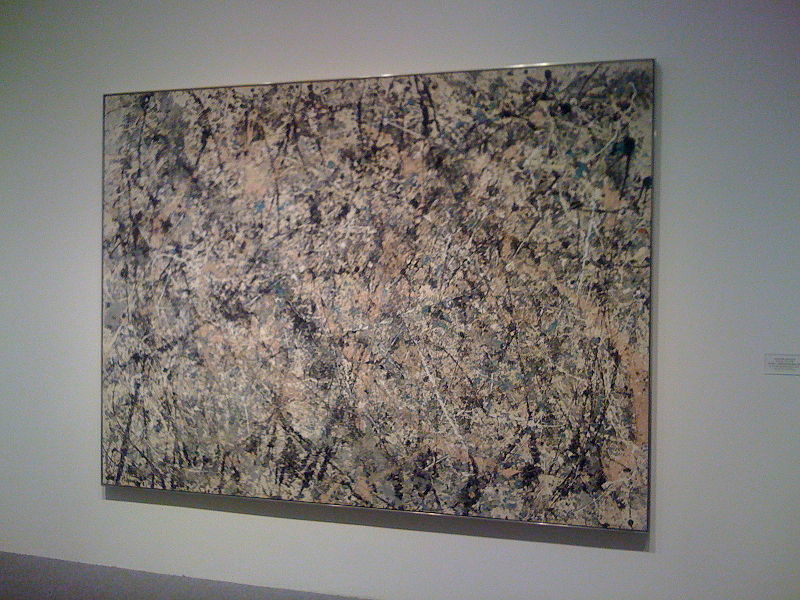| Jackson Pollock | |
|---|---|
 |
|
| Born | Paul Jackson Pollock Jan. 28, 1912 Cody, Wyoming, U.S. |
| Died | Aug. 11, 1956 (at age 44) Springs, New York, U.S. |
| Nationality | American |
| Education | Art Students League of New York |
| Movement | Abstract expressionism |
| Field | Painter |
| Works | View Complete Works |
Jackson Pollock was born January 28, 1912 in Cody, Wyoming. He was the fifth and youngest son. When he was a year old his family moved to Arizona, and then to Chico, California. His dad started off as a farmer, but when that failed he became a land surveyor for the government. Since Jackson would go with his dad when he went land surveying, he was exposed to Native Americans and their art which would later influence his work. He attended the Los Angeles Manual Arts High School where he was persuaded to go into a career in art.
In 1930 he followed his eldest brother, Charles, to New York City and moved there. He studied under Thomas Hart Breton at the Art Students League of New York City with his brother. At the yearly school exhibit, he met his future wife, Lee Krasner, another fellow artist, while she was viewing his work. From 1935 to 1943, he worked for the Works Project Association (WPA) Federal Arts Project (FAP), which meant he was employed by the government.
Pollock was introduced to liquid paint in 1936 by Mexican muralist David Alfero Siquerios, but he didn’t use it until his drip period. His early art is influenced by Picasso and Míro, as well as Surrealism and Native American art (particularly sand drawings). Jackson’s work during the Great Depression has strong Native American tones and Surrealism mixed together, which happens to be a reoccurring theme in his art. In 1943, Jackson had his first solo exhibit. Peggy Guggenheim sponsored it and guaranteed him a salary of $150 a month.
Jackson and Lee were married in October of 1945. Pollock’s patron and art dealer, Peggy Guggenheim, lent then the down payment for their house in Springs on Long Island. Their house had a shed for Pollock to paint in, and a room in the house for Lee to paint in.
At last, Pollock hit gold. When he began to drip paint onto the canvas, it was deemed genius. His work became so famous in America during the 1950’s he had a four page spread in Life Magazine that asked if he was the greatest painter alive. In an interview, he was asked how this came to be and he replied “The method of painting is the natural growth out of need. I want to express my feelings rather that illustrate them… I can control the flow of paint; there is no accident, just as there is no beginning and no end.”
When asked about his painting technique, he stated “I prefer to tack the unstretched canvas to the hard wall or floor… On the floor, I am more at ease. I feel nearer, more a part of the painting, since this way I can walk around it, and work from the four sides and literally be in the painting.” As for his tools, “I continue to get away from the usual painter’s tools such as an easel, palette, brushes, etc. I prefer sticks, trowels, knives, and dripping fluid paint or a heavy impasto with sand, broken glass, or other foreign matter added.”
He was most famous from 1947 to 1950. He produced artworks like Autumn Rhythm (Number 30), 1950. It is composed of, brown, black, and white—very basic colors. Like Pollock said in his quote, he tries to express feeling here by the motion of the work instead of conveying it through the colors. Many paintings by him don’t have names; instead, they are numbered so it doesn’t give the piece a symbolic meaning, just a feeling.
From 1950 to the end of his life, Jackson did not paint at all. He had been an alcoholic all his life, and now the liquor had totally taken control. His drunken escapades split Pollock’s marriage apart, especially when he got a mistress. To get away from the mess, Lee went to Europe to think about her marriage and where it was going, and what the next course of action would be. Pollock, on the other hand, stayed in town, and went out to bars with a few friends. When he was driving back home that fateful night, he flipped his convertible and killed his friend Edith Metzgen and himself. His mistress, Ruth Klingman, was the only one to survive the crash. Lee found out about the crash the next day. Jackson Pollock died on August 11, 1956 at 10:15 pm while driving under the influence. He was buried at the Green River Cemetery near Springs where they lived. Lee was buried there as well. Their house is now the Pollock-Krasner House and Study Center. Pollock changed American art history by becoming the first abstract artist to be taken seriously by the European artists, and the first American artist to receive major national attention for his work.

